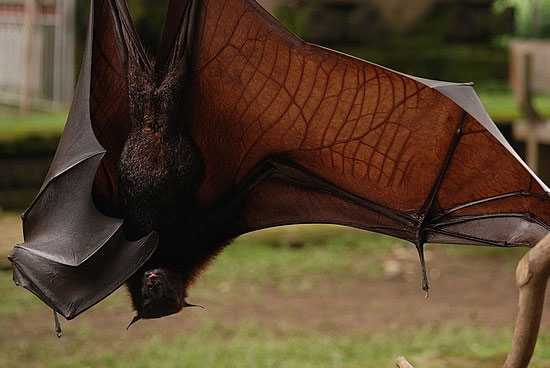Indonesian bat species face extinction
Bats in Indonesia are threatened, when 4 out of 225 species are now almost at extinction.
The leading expert Ibnu Maryanto bat of the Center for Biological Research, Indonesian Academy of Sciences (LIPI) said it is the species Otomops Johstonoi (in Flores and Alor), Neoptenus Trostii (in Sulawesi), Rouseptus Linduenst (in the lake Lindu, Sulawesi) and Otomops Forrmosus (in Java).
According to scientists, indiscriminate exploitation, deforestation and overexploitation in limestone areas - the habitat of familiar bats - are the main factors that threaten and reduce numbers. bat species.
LIPI Director Lukman Hakim said that bats play an important role in balancing the ecological system and are useful for human life, when it is one of the mammals, eating natural insects and receptors. chalk for plants.

Artwork (Source: waspada )
Of the 225 species of bats in Indonesia, there are 75 species of fruit, insects and pollinators, 148 are insectivores that help people fight insects and diseases.
In an hour a bat can eat 6,000 insects. Therefore, it is easy to see how mosquito-borne malaria will be common if the bat species is no longer available . Currently Indonesia's farming industry has seen the effect of a decline in the number of bats in the role of pollinators.
Unfortunately, the familiar habitat of bats has been intervened and destroyed by humans throughout Indonesia, from Jakarta, to Bogor, from Depok to Bekasi, as well as at most forests in the country.
Mr. Lukman Hakim said that LIPI is very concerned about the environment and will strengthen cooperation with bat researchers in Southeast Asia and around the world.
LIPI organized international bats workshops from June 6 to 9, with the participation of 80 researchers from 20 countries, including Indonesia, Malaysia Philippines, Brunei, Vietnam and Cambodia. Laos, Singapore, India, China, Japan, USA, Canada, England, Australia, Pakistan, Vanuatu and Taiwan territories.
This is the second workshop after a similar workshop held in Phuket, Thailand in 2007.
- Tens of thousands of species may disappear
- Many plants and animals are in danger of extinction
- 16,000 species face extinction
- 25% of mammals are at risk of extinction
- Many plants face extinction
- The rarest animals in the 2009 Red Book
- Forget the dinosaurs, this is the most horrifying extinction in Earth's history
- Identify a new species that lasts for decades
- Earth faces the greatest danger of extinction
- Which species will 'inherit' the Earth when humans become extinct?
- The parasite is in danger of extinction due to climate change
- Thousands of animal and plant species are threatened in Mexico
 Animal 'suffering' after hibernation
Animal 'suffering' after hibernation Why do goats climb well?
Why do goats climb well? Scientists were surprised to see chimpanzees eating turtles
Scientists were surprised to see chimpanzees eating turtles Giant catfish died deadly due to drought in Thailand
Giant catfish died deadly due to drought in Thailand